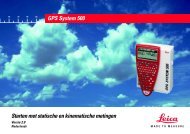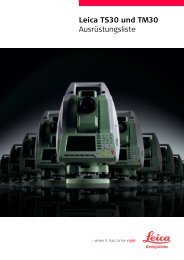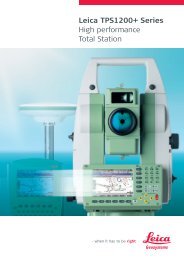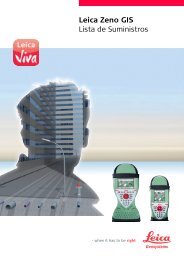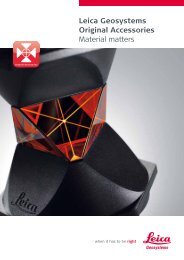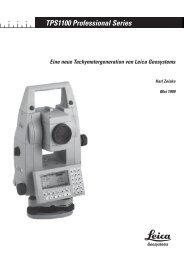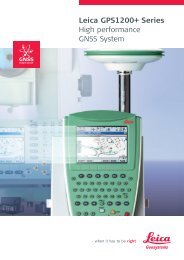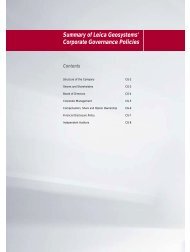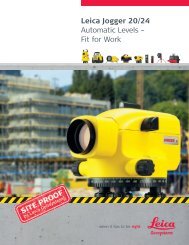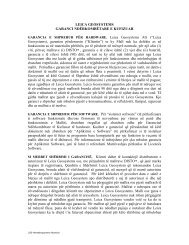The Global Magazine of Leica Geosystems
The Global Magazine of Leica Geosystems
The Global Magazine of Leica Geosystems
You also want an ePaper? Increase the reach of your titles
YUMPU automatically turns print PDFs into web optimized ePapers that Google loves.
under the mountain specifically for the surveying<br />
operations and the survey concept was designed to<br />
suit these conditions. “When you are underground<br />
you do not know how gravity is behaving in response<br />
to different rock densities – these errors would be<br />
transferred immediately into our measurements.<br />
<strong>The</strong>refore we refer back to survey models based<br />
on measurements we have taken on the surface,”<br />
explains Ivo Schätti.<br />
Dam wall monitoring on the surface<br />
While the tunnel boring machines are continuously<br />
eating their way through the base <strong>of</strong> the Gotthard<br />
massif, other measurements are being taken on<br />
the surface. Some parts <strong>of</strong> the tunnel pass directly<br />
under three water storage reservoirs, and although<br />
the tunnel lies very far underground, the effects on<br />
the surface should not be underestimated. “A tunnel<br />
affects the normal flows and pressures <strong>of</strong> ground<br />
water. <strong>The</strong> pressure loss due to the removal <strong>of</strong> the<br />
water in the rock could cause the mountain literally to<br />
cave in,” explains Ivo Schätti. A change <strong>of</strong> pressure like<br />
this could have disastrous consequences for the dam<br />
walls <strong>of</strong> the three reservoirs at Curnera, Nalps, and<br />
Santa Maria in the Upper Rhine Valley – and the tunnel<br />
driving would have to be stopped immediately.<br />
For this reason BSF Swissphoto AG, the lead surveying<br />
consultant <strong>of</strong> the ARGE Los349 consortium, is<br />
monitoring the valley walls near the dam walls and<br />
the area in front <strong>of</strong> them. Measuring points were<br />
fixed directly on the rock or were set on up to 3metre-high<br />
concrete pillars which the team constructed<br />
themselves. No easy task, given that all the<br />
materials had to be flown in by helicopter and the<br />
prisms fixed on to vertical rock faces. Highly precise<br />
<strong>Leica</strong> TCA2003 total stations, protected against<br />
the weather in small enclosures and controlled using<br />
<strong>Leica</strong> GeoMoS, measure the movements <strong>of</strong> the prisms<br />
and transmit the data to monitoring s<strong>of</strong>tware developed<br />
in-house. “<strong>The</strong> instruments have been operating<br />
since 2000 and continue to work perfectly,” he<br />
adds on behalf <strong>of</strong> a satisfied BSF Swissphoto. Spot<br />
level surveys were carried out at particularly critical<br />
areas along the route using a <strong>Leica</strong> GPS System 500<br />
to determine the settlement <strong>of</strong> individual points.<br />
<strong>The</strong> long, hard winters in the Swiss mountains make<br />
the team's job even more difficult: “In places the<br />
snow depths are huge, some points in avalanche<br />
areas are <strong>of</strong>f limits for the whole <strong>of</strong> the winter, and<br />
<strong>of</strong>ten ice forms on the prisms and can remain there<br />
all day. In spite <strong>of</strong> all this we have been able to reach<br />
90 percent <strong>of</strong> our points, even in the winter,” concludes<br />
Ivo Schätti.<br />
<strong>The</strong> <strong>Global</strong> <strong>Magazine</strong> <strong>of</strong> <strong>Leica</strong> <strong>Geosystems</strong> | 5



